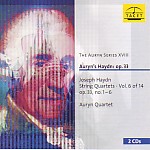This is easily the finest set of the Op. 33 quartets available. I can’t possibly discuss all of the wonderful things that the Auryn Quartet manages to do in this music, but a few examples should suffice. Take the opening movement of “The Bird” (No. 3). Haydn marks it Allegro moderato, but most quartets take it far more quickly. Yes, it sounds more “chirpy” that way, but in taking Haydn at his word the Auryn Quartet reveals a world of bittersweet emotion in this music, reminding us that ultimately it’s not about birds, but about human feeling. Additionally, the two-bar repeated-note lead-in has its own motivic significance, and taking the time to establish its characteristic portato articulation gives the movement additional personality. The finale, incidentally, chirps away uninhibitedly, as it should.
Next, let us recall that these are the “joke” quartets. Most groups don’t get the jokes, assuming that the music needs “help” in order to be funny. There’s a certain arrogance and want of taste in that approach: arrogant, because no one knew how to be funnier in music than Haydn, and a want of taste because the inevitable distortions and exaggerations that we often hear in these pieces actually draw attention away from the music’s humor and shift the spotlight to the antics of the performers. Instead of wit, we get vulgar slapstick (which Haydn also does better than anyone else–witness the Largo of Symphony No. 93–but the point is knowing the difference).
A great deal of musical humor depends on timing, and that means finding the right tempo and observing notated rhythms exactly. This is nowhere more important than in the finale of “The Joke” quartet (No. 2), where, for example, the Casals Quartet in its recent issue of these works slowed down, sped up, doodled with dynamics, and in general did everything they could to ruin the intended effect that depends entirely on playing in strict time and keeping the dynamics steady so that every phrase sounds like the previous one. The Auryn, however, plays it straight, and in this case “straight” means funny. And in the lachrymose aria that constitutes the Largo cantabile of the G major quartet, the first violin hams it up hilariously, using lots of vibrato (absolutely necessary), but again not distorting phrases or sounding mannered–making the music funny through timbre. In short, this is great quartet playing, magnificently recorded. Essential. [10/15/2009]
































